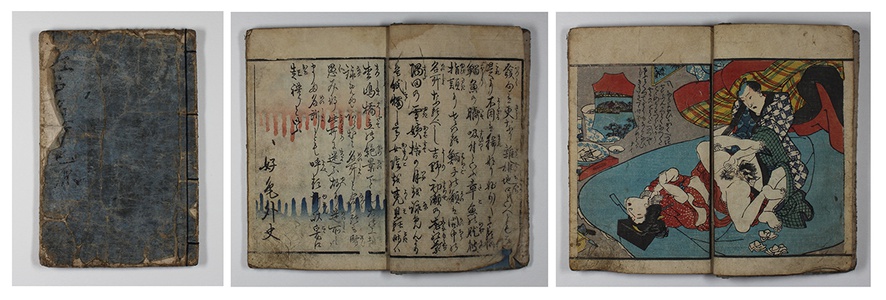| Method | |
| Artist | Utagawa School |
| Published | c.1850 |
| Dimensions | Chūhon. 180 x 120 x 6 mm |
| Notes |
Woodblock printed book. Ink, colour, and metallic ink on paper. Fukuro-toji (bag-bound) binding 22 pages. Three page introduction, three double page illustrations and one single page illustration followed by a 10 page erotic story. Extensive rubbing to covers causing some paper loss. Rubbing and soiling to pages on lower right and left corners throughout, manuscript writing in the upper margin of the fourth double page illustration, and on the margins of the eighth and ninth pages of erotic story, not affecting the images or text. Shunga is the term used for the body of erotic imagery produced in Japan from 1600 to 1900. The term shunga means spring pictures, a euphemism for sex, and is one of several names for erotic material produced in Japan. Shunga took different formats: painted hand scrolls, painted books, printed books and albums, and sets of prints which were sometimes sold in wrappers. As prints they are one of the genres of ukiyo-e, or Floating World prints, which also include fukeiga (landscape prints), and bijin-ga (prints of beautiful women). Most of the major ukiyo-e artists produced shunga material at some point during their careers, including Utamaro (who produced more erotic books than non-erotic books), Hokusai, and Hiroshige. Produced at the same time as the introduction of full colour woodblock printing, shunga prints and books were made using the most lavish and complicated printing techniques, including gauffrage, metallic inks, mica, complicated printed patterns, and multicolour printing using a high number of different colours. Although prolific in its number and variety, shunga should be seen as more representative of the ideals of the ukiyo, with its emphasis on mutual pleasure, rather than as an accurate representation of Japanese attitudes and practices of sexuality. Shunga present an invitation to pleasure through the bliss of lovemaking and though largely heteronormative, they portray the full gamut of couplings, married or otherwise, often surrounded by lavish settings and objects of pleasure. Utagawa School was the largest school of ukiyo-e art founded by Utagawa Toyoharu. After Toyoharu died his main pupil Utagawa Toyokuni I took over and led the group to become the biggest and most influential woodblock school of the 19th century. Pupils include Kunisada, Kuniyoshi, Hiroshige, and Yoshitoshi. Utagawa School is used an attribution when prints are unsigned and in the style of the school. Due to the punitive restrictions on shunga prints many works were produced without signatures or with pseudonyms. Ex. Col.: Peter Darach |
| Framing | |
| Price | £400.00 |
| Stock ID | 53285 |

